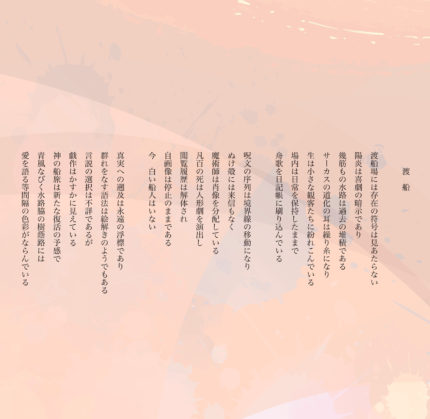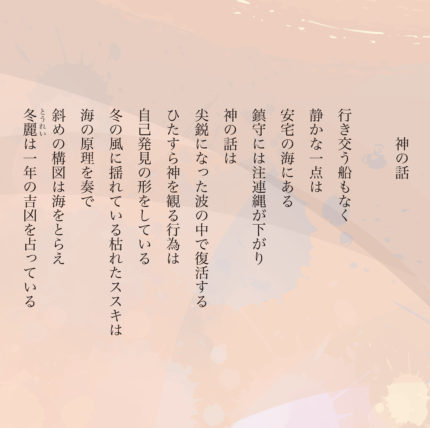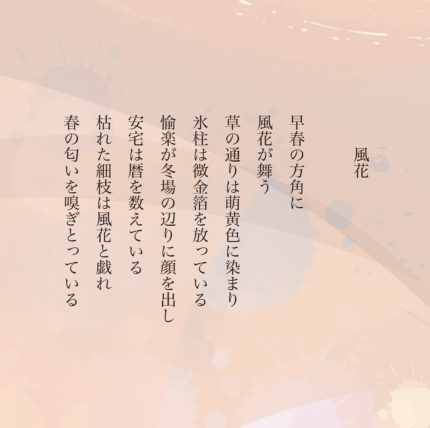- JEPAA Member
- Poet
- Akifumi Kurinami
- 詩
- 栗波昭文
© 2024 Akifumi Kurinami.
SCROLL
Portfolio /作品
- 渡船
- 神の話
- 風花
book /書籍
interview /対談

博学才穎の詩の哲人、現代に詩芸術の必要性を説く
クラウス・メンツ・ザンダー(以下ザンダー):今日はお時間をいただきありがとうございます。早速ですが、今回の出品作『神の話』について解説いただけますでしょうか。
栗波:私が若い頃によく通った石川県の安宅海岸にある、安宅神社という、船の安全を守る神社があります。そこでの祈る行為を見ましたときに、はっと詩の印象が浮かんだのですよ。神社には石の鳥居があり、しめ縄が張ってあります。稲わらを使って編んでいるのですが、これは蛇を模したものです。蛇の雄と雌が絡み合っている形です。
ザンダー:実は、私も浅草神社で同じものを見ました。あれは蛇に由来していたのですか。非常に興味深いです。

栗波:あのしめ縄が神秘的なもので、鳥居をくぐると神の域になります。結界と言い、神と現実の境を示すものです。そこをくぐると、そこは神の世界になります。ちなみに「神」という言葉は、人間が創った言葉の中で最高傑作であります。神に祈る行為は、神に語っている行為なのです。そして、それは、自分自身に語っている姿でもあります。私の詩では、「自己発見の形をしている」と表現されています。
ここで一番大事なことは、「神」イコール「自己自身」ということです。人間は、「神」という存在を創り、そこに自分を常に投影しながら自己を確立してきました。アインシュタインの特殊相対性理論ではないが、望遠鏡で見ていたら、自分の後頭部が映っているのと同じですね。
ザンダー:同感ですね。神への崇拝、祈りを捧げる行いもその枠に入ると思いますが、それもやはり、究極的には自分との対話と捉えられますよね。
栗波:そうですね。神に祈る行為は、自分との対話の構造になっているのです。
ザンダー:栗波先生の詩を読ませていただくと、また新しい情景が目に浮かび上がってきますね。そして、こうして先生と直接話すことによって、またいろんなことを知ることができる。これは、幸せなことですね。
栗波:ザンダー先生の住むドイツは、ヨーロッパという広大な大陸ですよね。地理的な話になりますが、ヨーロッパのような大陸と、島国の日本とは地形や風景は全く違いますよね。30年前に、ベルリンが統一する前の年に、西ベルリンと東ベルリン、ドレスデン、マイセンに行ったことがありますが、風景が違います。
ザンダー:いや、実は、景色だけではなく、匂いも全然違うんです。ベルリンの壁が崩壊してない頃の話ですが、東ドイツ側にはトラビというすごく排気ガスを出す車が走っておりまして、自分たちが東ヨーロッパに行きますと、あまりに臭くて吐きそうになったことをよく覚えています。
栗波:そういえばドレスデンも東ドイツでしたね。あそこは、中世の要塞都市でありましたし、大河の流れも悠々としていて、とても美しかったことを記憶しています。
ザンダー:しかし、ドレスデンは、悲しい歴史を持っている街なんですよ。1945年、終戦を迎えた本当にもう必要がなかったにもかかわらず、ドレスデンはアメリカ軍や他の国から攻撃を受けまして、全ての重要文化財も、めちゃめちゃに壊れた街なんです。広島のこともここに来る前、自分は調べてみたんですけれども、そのさなかでドレスデンのことを思い出しました。ドレスデンも本当にむちゃくちゃにされて、何もない、瓦礫の山になってしまったのです。
栗波:そうでしたか。私が訪れたときには、かなり復興されていました。街はきれいになっても、悲しい歴史がそこにあったという事実は残っていきますね。
ザンダー:ところで栗波先生は、ご自身の詩という表現について、どのように考えていらっしゃいますか?
栗波:詩というのは、言葉で構築した最高のアートと言えます。ただ、ヨーロッパと日本とでは、詩を作る環境として大いに違いがあります。詩の創作には時間と空間の自由度が不可欠です。ところが日本は、地震や台風など、自然災害が頻繁に発生します。梅雨、積雪、火山の爆発。日本は本当に世界の名だたる災害列島です。敷地面積でいうと0.05パーセントしかないのに、世界の災害の20パーセントが発生しているという計算になる、なんとも大変な国なのです。詩を作る環境という意味では、これほど難しい土地も無いかもしれません。そのため、ヨーロッパとは、詩の作りなども全然違います。ヨーロッパの場合には、大地は動かず、時間と空間が悠久のごとく存在しています。そのため詩の形体は、堅牢な言葉で構築され、論理的組み立てになっています。日本の場合には、土地が絶えず動きますから、いわゆる花鳥風月、四季折々の言葉がものすごくあります。それで作る短歌とか俳句。これは最高です。世界でも冠たるもの。しかし、詩は生まれ難い風土にあります。いったん災害が発生すると、救援、復旧に膨大な時間がかかります。時間のかかる思索や詩の創作をやっている環境ではありません。
日本の詩は、明治になり、新しい時代の思想や情感を盛るために新体詩として登場してきました。西洋詩の模倣から入り、必然的に発生したものではありません。そのため、詩は、脆弱で未熟です。多くは、短歌や俳句で表現できる歌材を意匠的にいじくった詩形になっています。今日でも同じ状況で、これは、能力の問題ではありません。
ザンダー:しかし栗波先生は、このように素晴らしい詩を作られていますよね。そんなに環境が違うだなんて、まったく考えの及ばないことでしたよ。それにしても、私は今日栗波先生とお会いするまで、創作活動の柱は、音楽、踊り、そして絵画と思っていたんですが、ここに詩を加えなければいけませんね。
栗波:そうですね。私自身は、その中でも詩は特別であり、アートの最高傑作と捉えています。
ザンダー先生は芸術の世界に生きてこられた方ですから、釈迦に説法になりますけど、人間は、他の動物と違って、一人で立って自由に歩けるようになるまでかなりの時間を要します。ということは、それを守るために社会とか家族で、その子どもを育成しなきゃいけないんですが、そのためには、家族だけでは無理で社会が必要になってきます。意思疎通を図るために必然的に言葉が生まれてきました。会話の中で、日常的なものは消えていきますが、特徴的な言葉の概念は、共同、共通の言葉として残され、社会集団を守る精神的シンボルとして大切にされてきました。それは、詩という形式で仕上げられ、伝承されました。その意味でも詩は、芸術の原形とも言えます。
ザンダー:そういった発想は、今まで思いもよらなかったですね。確かに言葉を使える動物は人間以外にありませんし、もっとも原始的な言葉に近い芸術は、詩かもしれません。とても興味深い見解です。
栗波:アートは、精神文化と物質文化のせめぎ合いから生まれていきます。ですから、あらゆるアートというのは革命であり、創作者は革命の申し子と言えます。ポピュリズムでは、芸術は生まれません。
ザンダー:先生のおっしゃるとおりだと自分も思います。自分もそのように思いながら、ずっと制作してきました。ピカソなんかも、きっとそういうふうに考えていらっしゃったと自分は思います。ピカソも本当に自分の中でいらないもの、全て除いたものを「そこのものの中にだけ真実がある」というふうにピカソが言っていますけれども、本当に自分を作るものだと思って精進しております。自分は探していない。それは来るものであると。そういうものがやっぱり芸術だと自分も思っております。
栗波:そうですね。よく分かります。よく降りてくると言います。
ところでザンダー先生は、カメラマンとしても活動されていたと聞きましたが、写真という芸術で、どう自分を表現されていきますか?
ザンダー:写真を撮るとき、まず被写体を見ますよね。その時に、いらないものをとにかく省いていくそうなんです。そこにだけ本当のことがあるといつも思っているので。無駄なものを取ったところに本当のものがあると思っているので、写真撮るときも実はそれが自分のスタイルです。
栗波:しかし、写真はすべてが写ってしまいませんか?
ザンダー:写真は撮りますが、しかし写るのは、その瞬間だけのものなのです。その瞬間。だから、ずっと待っていてその瞬間だけを撮る。その長かるものを撮るものではない。瞬間だけなんです。その一瞬という時間を切り取ることに、芸術としての表現があると考えています。
栗波:なるほど、画面としてという概念ではなく、長く続く時間の中で捉えるというお考えなのですね。よくわかります。
ザンダー:私自身は、写真を20年ほど撮り続けてきました。一番印象深いのは、海底の撮影ですね。海の中というのは、絶えず動いていまして、それが潜っていると実感できる。私は、その一瞬を捉えることに夢中でした。写真を撮るときっていうのも、本当に一瞬として同じ瞬間はないですから。その時は、まるで宇宙に行っているような気分でした。
栗波:すごいですね。一瞬を捉えるという感覚、よくわかります。確かに海の中は、写真を撮っていると没頭してしまいそうですね。
ザンダー:最後になりますが、日本は今年、年号が変わって新たな節目にあります。今後の創作活動について、何か新たな構想や思いなどはありますか?
栗波:物質文明というのは逆戻りは絶対しないので、これと競合させなければなりませんが、人間というのは自然の中の動物であるという根本的なところを抜きにすると、落とし穴にはまります。そのことを気付かせ、方向付けるのがアートと言えます。今回の台風の被害でも、いくらスマホが発達したところで、水と風には太刀打ちできなかったわけです。詩の場合には、やはり人間の心の奥底から湧き起こる心の滴を言葉に置き換えていく作業になります。特に、これからの時代は、情報化社会がさらに加速していきますが、芸術や哲学が最高位に位置づけられていなければ、健全な社会とは言えないでしょうね。
ザンダー:確かに、感情を込めるという行為がアートの仕事であり、表現者たちはそれにもっとも秀でた人間であるというご意見は、私も同意見です。ぜひこれからも詩表現を通じて心ある社会の必要性を訴えてください。本日は貴重なお話を聞かせていただき、ありがとうございました。

A talented and wise poetry philosopher who preaches about the necessity of poetry in modern times
Klaus Menz-Sander (hereinafter referred to as “Sander”): Thank you for giving me your time today. To start off, could you please explain the book you exhibited this time titled “The Stories of God”?
Kurinami: When I was young, I used to frequently visit the Ataka beach in Ishikawa Prefecture. On that beach, there’s a shrine that protects the boats sailing by called Ataka Shrine. When I saw people praying there, it suddenly dawned on me that their prayers were like poetry. At that shrine, there’s also a torii gate made out of stone as well as a Shinto prayer rope that’s placed across it. This rope is woven out of rice straw and is made to look like a male and female snake being intertwined with one another.

Sander: Actually, I saw the same thing at Asakusa Shrine as well. So it was modelled after two snakes after all. That’s very interesting.
Kurinami: The Shinto prayer rope is a mysterious object that allows you to enter the region of God when you pass through a torii gate. It’s also called a barrier, and it’s the boundary that separates God from reality. So once you pass through it, you enter the world of God. By the way, the word “God” is the best word to have ever been created by mankind. The act of praying to God itself is also the act of speaking to God, which is essentially the same as speaking to oneself. In my poems, I even describe it as “a form of self-discovery.”
The most important point here is “God” is equal to “oneself.” Also, the existence of “God” is something that’s been created by humans and is adopted by humans as a means of establishing themselves by constantly using it for self-projection. Even though this isn’t based on Einstein’s special theory of relativity, it’s essentially the same as theoretically seeing the back of your head when you look through a telescope.
Sander: I agree with you on that. I believe that worshiping and praying to God also fits into that idea since both acts can ultimately be seen as forms of communication with oneself.
Kurinami: That’s right. The act of praying to God is essentially a structure of communication with oneself.
Sander: When I read your poems, a new sight appears before my eyes. Also, by speaking to you directly like this, I’m able to learn a lot as well, which is something that I’m happy about.
Kurinami: Mr. Sander, your home country of Germany is situated in the vast continent of Europe. So geographically speaking, the terrain and landscapes in a continent like Europe would be completely different from that of an island country like Japan. Thirty years ago, I visited West Berlin, East Berlin, Dresden and Meissen on the year before the Berlin reunification. And what I found was the landscape was different in each location I went to.
Sander: Yes, but it’s not only the landscapes because the smell is actually completely different too. During the time when the Berlin Wall was still intact, people in East Germany used to drive a car that released a lot of exhaust fumes called the Trabi. I clearly remember how the smell was so bad that we’d even feel like vomiting whenever we went to Eastern Europe.
Kurinami: Come to think of it, Dresden was a part of East Germany too. Back in medieval times, it used to be a walled city. Also, I remember how the river there flowed gently and was very beautiful as well.
Sander: But Dresden is a city with an unfortunate history. In 1945, despite the fact that the war had already ended, the U.S. military along with other countries attacked Dresden and destroyed all of its important cultural properties. Before coming here, I also did some research on Hiroshima. But as I was doing that, I remembered what had happened to Dresden. Dresden was truly in shambles. There was nothing left and the city was just a pile of rubble.
Kurinami: Really? When I visited Dresden, it had already recovered considerably. I guess that even though it’s become a beautiful city, the fact that it has an unfortunate history still remains there.
Sander: By the way, what do you think about the artistic expression in your own poetry?
Kurinami: Poetry may be considered the highest form of art that’s constructed out of words. But the environment for writing poetry differs greatly between Europe and Japan. Creating poetry requires freedom in both time and space. However, natural disasters such as earthquakes and typhoons occur frequently in Japan. The country also suffers from the rainy season, snow fall, as well as volcanic eruptions. Therefore, Japan is truly notorious for being the world’s disaster-prone archipelago. Also, despite occupying only 0.05% of the world’s land, 20% of all the world’s natural disasters occur in Japan as well. So in terms of an environment for writing poems, there may not be any other place that makes poetry writing as difficult as Japan. Because of this, creating poetry in Japan is completely different from that of Europe. In Europe, the land does not move and it feels as though time and space exist eternally. As a result, the poetry written there uses robust language and is formed logically. However, in Japan, the land moves constantly, so a lot of the words used in poetry describe the beauties of nature as well as the four seasons. The poems created from such an environment such as the tanka and haiku are the best. They’re also unrivalled in this world. However, these poems exist in a climate where poetry writing is difficult. In Japan, once a disaster occurs, an enormous amount of time is spent on relief and recovery efforts. Therefore, it’s not an environment that’s conducive to lengthy contemplations or poetry writing.
The beginning of the Meiji era also saw the emergence of a new style of Japanese poetry that was filled with the thoughts and feelings of the new era. However, this style of poetry was fragile and underdeveloped as it did not emerge naturally and was created by imitating western poetry. Many of the poems that were written in this style consisted of verses that were designed to contain poetic content that could be used in a tanka or haiku. The same circumstances still exist today. However, it’s not a problem that concerns skill.
Sander: But you still made such wonderful poems despite this. Also, it totally never occurred to me that your environment was so different from mine. Before meeting you today, I used to think that the pillars of creative activities were music, dance, and painting. However, I now think that poetry needs to be added here as well.
Kurinami: That’s right. I personally consider poetry to be a special form of art amongst the ones you mentioned. But I think it’s also the best art form to ever exist.
Since you’re someone who’s been living in the world of art, it’s not really my place to be preaching to you, but I’d like to mention that unlike other animals, humans take a considerable amount of time to learn how to stand and walk freely on their own. In other words, in order to achieve such a feat, a child needs to be raised by society as well as their own family. So that’s why it’s necessary to have not only a family but society as well. Also, language is something that was created out of the necessity to understand one another. So while everyday matters that are brought up in conversations disappear overtime, language that is distinct remains as the common language and is valued as a spiritual symbol that protects social groups. This common language is also something that’s been handed down in the form of poetry. So in that sense, it may be safe to say that poetry is the original form of art.
Sander: I’ve never thought about that sort of thing before. There’s no doubt that no other being besides humans use language. Also, the art form that’s closest to primitive language may be poetry as well. So it’s a very interesting point of view that you brought up.
Kurinami: Art is created from the conflict between spiritual culture and material culture. So it may be said that every form of art is a revolution, and that the creators of art are children sent from god to execute these revolutions. Also, it’s not possible for art to be created out of populism.
Sander: I think you’re right about that. I’ve always thought that way as I was creating art. I think Picasso would’ve surely had these sort of thoughts as well. Picasso used to say that “the truth lies only within the things you truly do not need as well as all the things you’ve removed.” He also truly devoted himself to art while thinking of it as a way of creating himself. Additionally, I believe that art is, of course, something that comes naturally to you rather than something that you have to find yourself.
Kurinami: That’s right. I understand what you mean. You could also say that it’s something that descends from above.
By the way, I heard that you’ve also worked as a photographer. So how do you express yourself in the art of photography?
Sander: When I take a picture, I first look at the target I’m about to photograph. As I’m doing this, I also seem to filter out the things I do not need as I’ve always thought that the truth can only be found when the unneeded things are taken away. Since I believe the truth lies in places where the unneeded things have been removed, my style of photography actually revolves around this idea as well.
Kurinami: But if that’s the case, wouldn’t you just photograph everything in your pictures then?
Sander: When I take a picture, what ends up being photographed is what I saw at that very moment and nothing else. I basically have to wait a long time just to photograph that moment. So while taking a picture, I’m only photographing that specific moment and not all the occurrences leading up to it. I think that capturing that one moment is also a form of artistic expression in itself.
Kurinami: I see. So it’s not about aiming for a certain image, but rather capturing something within a long time frame. I totally understand that.
Sander: I’ve been doing photography for about twenty years. The photo that left the deepest impression on me was the one that I took of the ocean floor. When you’re under water, you can also experience the sensation of the sea being in constant motion. So I was very much fixated on capturing that moment. Also, when I went to take the picture, there was really no singular moment that was the same as any other moment. During that time, I felt as though I was in space.
Kurinami: That’s amazing. I totally understand the sensation of capturing a single moment. Taking pictures under the sea also seems like something that people would definitely be absorbed in if they tried it for themselves.
Sander: Lastly, since Japan has entered into a new era this year and is currently at a new turning point, do you have any new ideas or thoughts concerning your future creative activities?
Kurinami: Material civilization is irreversible, so it’s something that we have to grapple with. However, if we took away the fundamental idea that humans are animals in nature, we’d be stuck in a pitfall. Therefore, recognizing this idea and giving it a sense of direction is what we may consider to be art. Even with the damage caused by the typhoon recently, I realized that no matter how much the smartphone has developed, we’re still unable to compete with wind and water. In the case of poetry, it’s a form of art that’s created by putting together words to embody the fragments of our souls that well up from the depths of our hearts. In the coming era in particular, the development of our information society will accelerate even further, which means that we will need to treat art and philosophy with the utmost priority in order to build a healthy society.
Sander: Yes, I also believe that art is a medium that allows people to express their emotions, and that the creators of art are the most excellent individuals out there. So please continue to spread awareness for the need to build a compassionate society through your poetry. Thank you for sharing your valuable thoughts with me today.
Solo Exhibition /個展
栗波昭文 特設個展ブースin 日本ベルギー芸術交流展2021
会期:2021年8月5日~19日
会場:サン=ジュリー・ホール(ベルギー・ブリュッセル)
主催:一般社団法人 日欧宮殿芸術協会
運営:クリエイト・アイエムエス株式会社
栗波昭文 特設個展ブースin 日欧宮殿芸術祭2021
会期:2021年6月4日~6日
会場:シャルロッテンブルク宮殿(ドイツ・ベルリン)
主催:一般社団法人 日欧宮殿芸術協会
運営:クリエイト・アイエムエス株式会社
栗波昭文 特設個展ブースin アジアジャパンアートビエンナーレ2021
会期:2021年6月4日~6日
会場:ザアートハウス(シンガポール)
主催:一般社団法人 日欧宮殿芸術協会
運営:クリエイト・アイエムエス株式会社
Profile /経歴
栗波昭文 Akifumi Kurinami
1946年 福井県出身
作品出展国遍歴(JEPAA関連事業):ドイツ、フランス、カナダ他
Born: 1946 Hukui, Japan
Exhibition of Works(JEPAA): Germany, France, Canada…








